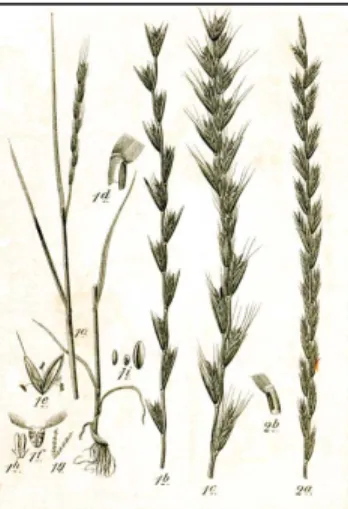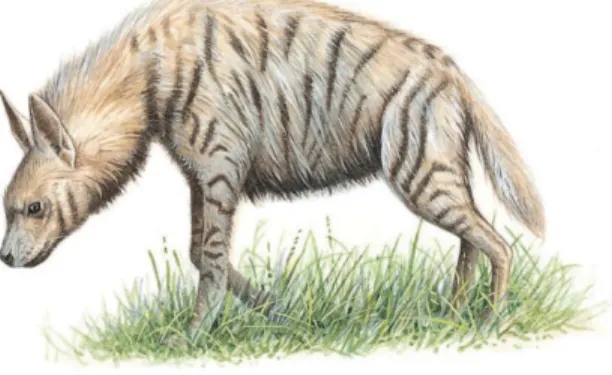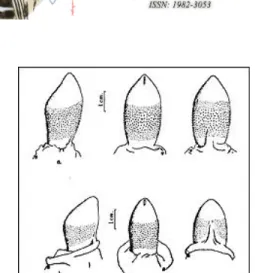"A wheat may change into a zunin and a male hyena into a bat": Transformation of Plants and Animals in the Literature of the Jewish Sages
“Um trigo pode se transformar em um joio e uma hiena em um morcego”: Transformação de plantas e animais na literatura dos sábios judeus
Abraham Ofir Shemesh* Ariel University | Ariel, Israel avi0603@013.net.il
Abstract: A prevalent Talmudic theory claims that both animals and plants can change,
whether in the development process of the embryo or throughout the life of the organism. The current article analyzes the concept of the transformation. It shows that this view was rooted in Greco-Roman literature and the Jewish sages derived their outlook from the classical world with which they were familiar.
Keywords: Talmud. Greco-Roman Literature. Animals and plants.
Resumo: Uma importante teoria talmúdica afirma que tanto os animais quanto as
plantas podem mudar, seja no processo de desenvolvimento do embrião ou durante a vida do organismo. Este artigo analisa o conceito de transformação. Essa visão estava enraizada na literatura greco-romana e os sábios judeus deram sua visão do mundo clássico com o qual estavam familiarizados.
Palavras-chave: Talmude. Literatura Greco-Romana. Animais e plantas.
The main approach mentioned in Tannaitic and Amoraic literature is that basically a certain species, plant or animal, bears fruit or develops according to its traits. This fact was mentioned in various sources. For example, the Bavli (Nidd. 31a) says of the sowing of species of vegetables: "If a man puts different seeds in a bed each grows in the manner of its own particular species, whereas the Holy One, blessed be He, fashions the embryo in the woman's bowels in such a manner that all grow into one and the same kind." Similarly, it says about crops: "Have you ever sowed and nothing grew or have
you ever sowed wheat and harvested barley".1 Namely, normally the seed of a certain species of plant develops into the same species.
Nonetheless, there is a prevalent Talmudic theory whereby both animals and plants can change, whether in the development process of the embryo (i.e. pre-birth) or throughout the life of the organism. In this paper, I shall show that the concept of the transformation is rooted in Greco-Roman literature, and that the Jewish sages derived their outlook from the classical world with which they were familiar.2
1 Plants Transformation in Talmudic Literature
Jewish sages refer to the phenomenon of transformation of plants in both halakhic and philosophical contexts. For example, they say that during the creation of the world the earth deviated from God's orders and brought forth barren trees as well, although the original plan called only for fruit trees:
And if so, why was the earth cursed? R. Yuden bar Shalom said: For disobeying the decrees of the Holy One, blessed be He. [It says] 'Let the earth bring forth grass, the herb yielding seed' and it did not do so, rather 'And the earth brought forth grass, and herb yielding seed after its kind'. Rabbi Pinchas said […] it added barren trees" (yKil. 1:7, 27b).
A similar theory is put forth by Israeli Amoraim on behalf of previous sages. R. Lulini of the fourth generation and R. Azarya of the fifth generation cite a tradition that explains the complete annihilation of the generation of the flood as caused by the transformation of the natural-normal behavior of creatures, human beings, animals, and even the earth and the plants that grow in it:
R. Azarya in the name of R. Yehuda: Everyone behaved abominably in the generation of the flood, the dog with the wolf, rooster with the peacock, that is what is meant by 'for all flesh had corrupted etc' (Gen. 6:12), R. Lulini bar Tiberi in the name of R. Yitzhak: Even the earth fornicated. They would sow wheat and the
1 FINKELSTEIN, 1969, Sifre on Deuteronomy, Piska 306, p. 332.
2 The influence of the Greeks and Romans on the Sages’ knowledge of biology was tested in a rather limited field experiment. See, for example, LIEBERMAN, 1962, p. 180-93; FELIX, 1992, p. 20-21.
earth would produce zunin, these are the zunin of the generation of the flood.3
Researchers of the Talmudic botany identify the zunin in this passage as Lolium
temulentum or Cephalaria syriaca, and it seems that the first suggestion is more reasonable
(Figure 1).4 The phenomenon of the transformation of plants was mentioned in rabbinical literature in the context of the laws of kilayim ("Mixture", prohibition of crossbreeding seeds, crossbreeding animals). The Mishna in Tractate Kilayim (1:1) states that wheat and zunin that are in the field together are not kilayim: "The wheat and the
zunin are not kilayim in each other". In the midst of the discussion in the Tannaitic
source, the Yerushalmi (Kil. 1:1, 26d) asks: "From now they [the zunin] will be kilayim with wheat?" To this Rabbi Yona, one of the greatest Palestinian Amoraim of the fourth generation, replies: "They are a species of wheat, in which the fruit fornicate, as it is written: 'And the land shall not fornicate'. From here we know that the fruit fornicate".
Figure 1: Lolium temulentum: stem and seeds.
3 THEODOR and ALBECK, 1903, Genesis Raba, Parasha 28, 6, 7, p. 226. Compare to the
midrash that likens marriage to a daughter of Aner, Eshkol, or Mamre to the danger ensuing from the transformation of wheat into zunin, i.e., there is a concern that the offspring born of this marriage would be corrupt like the transformation of wheat into
zunin (Genesis Raba, ibid., 59, 3-4, p. 636).
4Lolium temulentum has a few common English names: Bearded ryegrass cockle, darnel
or poison darnel. From now on, I shall use the Hebrew name zunin. I have adopted the identification of FELIX, 1967, p. 22. CHIZIK, 1952, p. 802 suggested that this is Cephalaria
Namely, In fact, wheat and zunin are species of wheat, such that they do not form
kilayim when mixed, however in practice superior species of wheat lose their good traits
and become inferior species or weeds.5 Interestingly, some of the interpretations of the curse of Adam see the transformation into weeds of cultural species sown by man in his field as a punishment for Adam's sin. Aside from the bad effect of the sin on the sinner himself, wider circles are affected as well. The sin causes a distortion of nature and a deviation from the biological processes that operate within it.6
It may be noted that the theory of the transformation of plants became embedded in Jewish medieval agricultural folklore. Rabbi Nathan ben Yeḥiel me-Romi (Rome) who lived and operated in Italy in the 11th century referred to the agricultural phenomenon of plant transformation in his interpretation of the bHor. 13a:
Some legumes have been transformed, like zunin in wheat. Thus, the legumes in these beans are sealed and hard and are not edible by human teeth, and birds and beasts do not eat them either because they are sealed and hard as a rock, and these are called
gugmi in Aramaic.7
Rabbi Nathan ben Yeḥiel me-Romi refers to the transformation of legumes' qualities, such as the transformation of the broad bean (Vicia faba). Just as wheat is supposed to produce edible kernels, but sometimes they become zunin, which are bitter and ruin the dough, so sometimes the qualities of beans and other types of legumes are transformed for the worse. In these cases the legumes become hard and only mice can eat them.
3 Transformation of animals in Sages' Texts: The Case of the hyena
The main example of the transformation of animals in sages literature is that of the striped hyena (Hyaena hyaena syriaca), a nocturnal predator that feeds on small animals as well as carcasses and their bones (Figure 2). According to Yerushalmi hyena can change its sex: "male hyenas become female" (yShab. 1:3, 8a). The Talmud Bavli (B. K.
5 FELIX, 1967, p. 19. And compare to the Mishna Ter. 2:6, which states that although in regards to kilayim wheat and zunin are considered one species, donations of wheat to the temple are not given from zunin because they are inedible. I.e., the two are not always considered identical, and there are variations between the different halakhic fields.
6 This approach to Adam’s punishment is taken by Rashi in his interpretation of Gen.
3:18: "And it will cause thorns and thistles to grow for you – The earth – when you sow it with various species of seeds – will sprout thorns and thistles, artichokes and cardoons, which are edible only after preparation."
16b) adds that a male hyena may change into other animals and therefore appears in rabbinical literature under three different names bardelas, naphraza and apa:
The male hyena [zavoa] after seven years turns into a bat [ataleph], the bat after seven years turn into an 'arpad' [arpad], the 'arpad' after seven years turns into a 'kimosh, the 'kimosh' after seven years turns into a 'xoax', the 'xoax' after seven years turns into a demon [shed]. The spine of a man after seven years turns into a snake [naḥash].
As noted by the Israeli zoologist Menaḥm Dor, it is difficult to identify the animals in this Talmudic source with certainty, and the source may refer to mythical animals. 8 According to this source, the hyena ultimately turns into a devil, undoubtedly a creature arousing fear in the ancient world, which alludes to the hyena’s potential to cause harm and have a devilish nature.
Figure 2: Striped hyena.
4 The origins of transformation theory: The classical literature
As we stated before, the concept whereby animals and plants are transformed into other species appears in Greco-Roman agricultural and natural literature. The abnormal sexual organs of the hyena was described a few centuries before the Yerushalmi in the classical sources. Aristotle (384-322 BC) had declared in the Historia animalium: "The statement is made that the hyena has both male and female sexual organs; but this is untrue."9 Namely, many Roman Scholars hold the theory that hyena is hermaphroditic animal.
8 DOR, 1997, p. 259. For a discussion on the identification of these creature, see GINZBERG, 1942, v. V, p. 58.
Pliny the Elder (23-79 AD) refers to the statement of Aristotle in his book Naturalis
Historia. He writes: 'The hyena is popularly believed to be bi-sexual and to become male
and female in alternate years. The female bearing offspring without a male; but this is denied by Aristotle."10 Although Pliny expressed his disagreement with Aristotle on the belief in the hyena’s ability to change its sex, he supported this belief. In another source, he presents this belief without qualification.11
Regard to the transformation of plants Pliny the elder reports on changes that occur in various crops and why this is so. He writes:
The first of all forms of disease in wheat is the oat .Barley also degenerates into oats, in such a way that the oat itself counts as a kind of corn, inasmuch as the races of Germany grow crops of it and live entirely on oatmeal porridge. The degeneration in question is principally due to dampness of soil and climate, but a subsidiary cause is contained in weakness of the seed if it is held back too long in the ground before it shoots out.12
In the agricultural folklore of the classical era, oats (Avena) were seen as a weakened form of higher quality crops, such as wheat and barley. Pliny suggests that the scientific explanation has to do with the moistness of the ground and the climate, but sometimes, albeit secondarily, also as a result of slowly sprouting seeds.
In fact, the issue of plant transformation aroused disagreement among non-Jewish sages, and some objected to this concept. In his book 'Hexaemeron', a collection of nine sermons on five of the six days of creation, written by Christian theologian Basil the Great (329-379 AD) of Caesarea in Cappadocia,13 the author presents a theological theory whereby God created all creatures in a certain format, such that no claim can be made of changing their original form. Basil the Great writes:
So let the earth put forth herb, grass sowen as seed for its kind” […] So how does the earth put forth every seed for its kind? For how often do we sow grains of fine wheat, and we find that they become a different sort in black! This does not mean that they
10 PLINY, 1949, VIII, 105.
11 See PLINY, 1949, XXVIII, 92 and compare to OVID XV, 409, who presented a similar
view.
12 PLINY, 1949 V, 18, 149.
13 On Basil the Great and his theological composition 'Hexaemeron' see: BEBIS, 1997, p. 273-285; CORONA, 2006, p. 6-28.
changed from their own species to become thus; but it happened to them as a form of illness and disease. For the wheat did not fail to become wheat in that colour, but from the burning that happened to it from the cold it received the mark of blackness. From the very name you can learn about its appearance. For from the severity of the ice it was burned so it took on another colour and a different taste. Those who have experience of seeds say that if there occurs for it a temperate and mild air with good earth, it returns again and is reestablished in the form in which it originally was. So without the command of God it is impossible for those things which grow from the earth to attain completion in a different form.14
Basil believed that plants may change, but not to other species. Wheat kernels often change their traits, but this is the result of a disease. For example, wheat kernels become black as a result of the cold, but it is clear that weeds are not formed from wheat. Fundamentally, his approach is logical, as ground, weather, and precipitation also have an impact on plants, but not in a way that transforms them into other species. Clearly, for example, as a result of extreme heat, disease, or large quantities of rain, plants might change their regular appearance.
5 Discussion: Is there any basis to the ancient theory of transformation of wheat and hyena?
The fundamental question that arises in light of everything presented above is: Does the phenomenon of plant or animal transformation described in both Jewish and non-Jewish ancient writings, have any botanical or zoological basis, or is this a completely fictional concept?
The basis of the concept of plant transformation mentioned in the ancient sources seems to be an interpretation of the affinity and differences between two related plants located together in the same cultivated field. For example, the ancients discerned the morphological-botanical resemblance of wheat and darnel, manifested among other things in their external appearance or their parts, for example the flower which is a
spike.15 On this basis they attempted to explain this phenomenon as transformation from one species to another due to different physical conditions.
The relationship between wheat and darnel, mentioned together often in Jewish sources, is a good example for explaining the logic of the ancients' theory of plant transformation, and therefore we shall focus on it. According to the modern scientific conception, the phylogenetic resemblance between the two is evidence of an ancient evolutionary connection. Furthermore, darnel is a segetal plant (arable plant), i.e. a weed whose main area of dispersal is currently cultivated fields. In general, segetal plants have several qualities that are valuable for their adaptation and that ensure their dispersal in agricultural fields.16 Darnel has similar qualities to those of wheat, which help it maintain its existence in grain fields.
In the case of the hyena, some zoologists believe that the source of this belief is the appearance of the large female clitoris, which is similar to the male sexual organ (Figure 3). The American zoologist Stephen Jay Gould explains why the legend that the hyena is hermaphroditic is false:
The legend had arisen for a good reason. Female hyenas are virtually indistinguishable from males. Their clitoris is enlarged and extended to form an organ of the same size, shape, and position as the male penis. It can also be erected. Their labia have folded up and fused to form a false scrotum that is not discernibly different in external form or location from the true scrotum of males. It even contains fatty tissue forming two swellings easily mistaken for testicles. British zoologist L. Harrison Matthews wrote the most extensive anatomical description of the hyena's sexual anatomy in 1939 (Figures 4-5). He described the peniform clitoris, emphasizing that it is no smaller than the male penis.17 However, this is true only for the spotted African Hyaena which distribution reaches Egypt. In the case of the striped hyena, there is no difficulty to distinguish between the male and the female genitals. According to this, it is possible that the Yerushalmi editors
15 Even according to the modern botanical method of classification, these two are included in the same family of plants – Gramineae [Poaceae]. See FEINBRUN-DOTAN and DANIN, 1991, p. 859.
16 On segetal plants and their reproduction in agricultural fields see ZOHARY, 1950, p. 387-411.
knew the spotted hyena or they drew their knowledge from the environment in which they lived.
Figure 3: spotted African Hyaena: female with pseudopenis.
Figure 4: External genitalia of female spotted hyena, showing penis form clitoris and false scrotum. From: Matthews, L. Harrison. "Reproduction in the Spotted Hyaena Crocula crocuta (Erxleben)," Philosophical Transactions of the Royal Society, Series B, v. 230 (1939), p. 1-78.
Figure 5: Similarity of male and female genitalia in the spotted hyena. Top row, views of the male penis. Bottom row, similar views of the female clitoris.
Bibliography
ARISTOTLE. History of Animals. Volume II: Books 4-6. Translated by A. L. Peck. Loeb Classical Library 438. Cambridge, MA: Harvard University Press, 1970.
BEBIS, George S. Introduction to the Liturgical Theology of St. Basil the Great. Greek
Orthodox Theological Review 42, 3-4 (1997): 273-285.
CHIZIK, Baruch. A Treasury of Plants. Herzlia: The author Publication, 1952 [Hebrew]. CORONA, Gabriella (Ed.). Ælfric's Life of Saint Basil the Great: Background and Context. Cambridge: D. S. Brewer, 2006.
DOR, Menaḥem. Animal Life in the Times of the Bible, the Talmud and the Mishna. Tel Aviv: Grapor-Daftal, 1997 [Hebrew].
FEINBRUN-DOTAN, Naomi and DANIN, Avinoam. Analytical Flora of Eretz-Israel. Jerusalem: Cana Publishing House, 1991 [Hebrew].
FELIX, Yehuda. Mixed Sowing Breeding and Grafting. Tel Aviv: Dvir Press, 1967 [Hebrew]. FELIX, Yehuda. Nature and Land in the Bible: Chapters on Biblical Ecology. Jerusalem: Reuven Mass, 1992 [Hebrew].
FINKELSTEIN, Eliezer Arye. Sifre on Deuteronomy. New York: Theological Seminary of America, 1969 [Hebrew].
GINZBERG, Louis. The Legends of the Jews. Philadelphia: Jewish Publication Society of America, 1942.
GOULD, Stephen Jay. Hyena Myths and Realities. Natural History 90 (1981): 16-24.
LIEBERMAN, Saul. Hellenism in Jewish Palestine. New York: The Jewish Theological Seminary of America, 1962.
R. NATHAN me-Romi. Sefer HaArukh Ḥanoch. Ḥanoch Yehuda Kohut Edition. New York: Pardes, 1955.
OVID. Metamorphoses.Translated by A.D. Melville; with an introduction and notes by E.J. Kenney. Oxford: Oxford University Press, 1986.
PLINY. Naturalis Historia. Translated by H. Rackham. Loeb Classical Library. London: W. Heinemann, 1949.
THEODOR, Julius and ALBECK, Ḥanoch. Genesis Rababh. Berlin: Itzkowski, 1903.
THOMSON, Robert W. The Syriac Version of the Hexaemeron by Basil of Caesarea, Corpus
Scriptorum Christianorum Orientalium. Lovanii: Peeters 1995.
ZOHARY, Zohary, The Segetal Plant Communities of Palestine. Vegetatio, 2, 6 (1950): 387-411.
---
Recebido em: 22/02/2017. Aprovado em: 21/04/2017.



